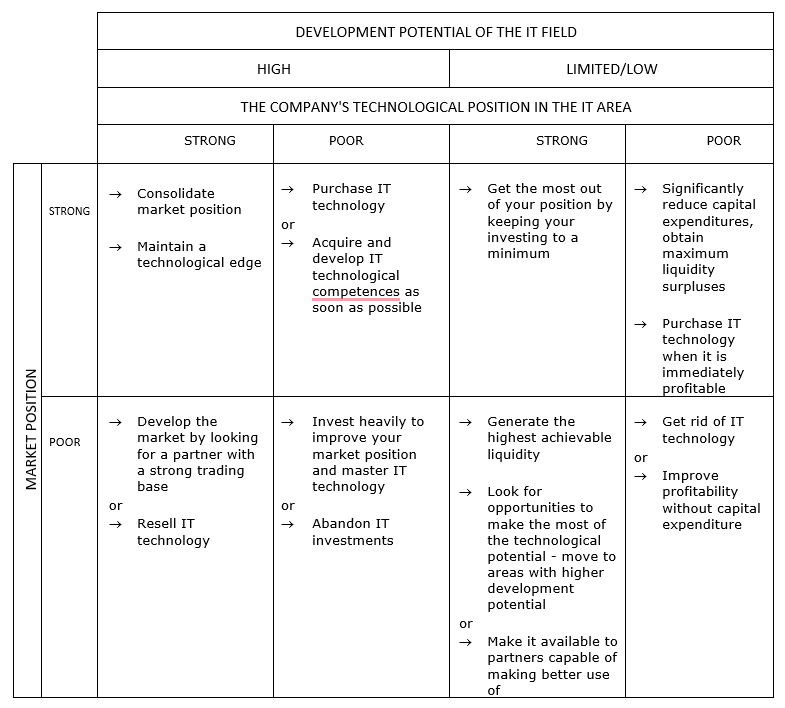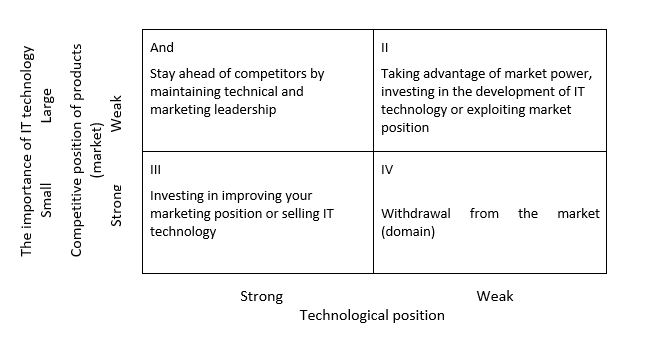Green Data Centers – How to Choose an Eco-Friendly IT Partner?
A Guide for Companies Looking for IT Providers Using Energy-Efficient Infrastructure and Renewable Energy
 Author:
Author:There exist many types of IT technology strategies, created for enterprises using different IT technologies, with different levels of advancement in the technology life cycle, with different external and internal conditions. One of the most common ways to determine an IT technology strategy model is through its selection, based on the following criteria [1]:
Assuming that the development potential of the IT field may be high or low (limited), and the market position and technological position may be strong or weak, a matrix has been developed which indicates how the operating strategies, including technological strategies, are to be adopted by an enterprise remaining in a specific technological situation (Tab. 1). Characterising the various situations in which an undertaking may find itself, the following can be stated.
Table 1. Models of IT technological strategies according to the development potential of the field and the market and technological position of the company

Source: In-house analysis based on: Strategor, company management. Strategies of Structure, Decisions, Identity, PWE, Warsaw 1995, pp. 151-154; S. Łobejko, Mission, strategy, innovation strategy [in:] A. Sosnowska + 5 Aut., How to implement technological innovations in a company. A guide for entrepreneurs, PARP, Warsaw 2005, pp. 36-37.
IT technology strategies are strongly linked to innovation. Hence, they can also be determined on the basis of the competitive position of products and the IT technology of their production, depending on the implementation of innovations (Characteristic. 1). In the case of a strong market and technological position, with the high importance of technology, the company can be ahead of competitors by maintaining technological and marketing leadership. With a strong technological position and a weaker market, it may be necessary to invest in improving marketing activity and strengthening market position. With a strong market position and uncompetitive technologies, the way to improve the situation would be to invest in technology development. The lack of market prospects and opportunities for technology development may mean that the company will have to withdraw from the market.

Characteristic. 1. Strategy for the development and commercialization of innovations
Source: S. Łobejko, Mission, strategy, innovation strategy, [in:] A. Sosnowska + 5 Aut., How to implement technological innovations in a company. A guide for entrepreneurs, PARP, Warsaw 2005, p. 38.
[1] Own elaboration based on: Strategor, Company management. Strategies of Structure, Decisions, Identity, PWE, Warsaw 1995, pp. 151-154; S.Łobejko, Mission, strategy, innovation strategy [in:] A.Sosnowska + 5 Aut., How to implement technological innovations in a company. A guide for entrepreneurs, PARP, Warsaw 2005, pp. 36-37.

Green Data Centers – How to Choose an Eco-Friendly IT Partner?
A Guide for Companies Looking for IT Providers Using Energy-Efficient Infrastructure and Renewable Energy
Green IT

Helm for the Second Time – Versioning and Rollbacks for Your Application
We describe how to perform an update and rollback in Helm, how to flexibly overwrite values, and discover what templates are and how they work.
AdministrationInnovation

Helm – How to Simplify Kubernetes Management?
It's worth knowing! What is Helm, how to use it, and how does it make using a Kubernetes cluster easier?
AdministrationInnovation